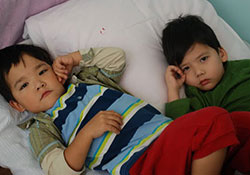Children in hospitals

WHO/Malin Bring
Severely ill children need skilled hospital care, but do not get it in some settings with limited resources. To address this, WHO developed the regional framework Improving the Quality of Care for Reproductive, Maternal, Neonatal, Child and Adolescent Health in the WHO European Region, as well as assessment tools to help professionals and policy-makers improve care for children and adolescents. WHO/Europe advises and supports countries in reforming their health systems and changing service providers’ skills and attitudes.
In most parts of Europe, severely ill children have good access to hospitals, with established referral systems and skilled and committed nurses and doctors. Nevertheless, in some settings children remain in hospital and away from their families unnecessarily and for too long; receive excessive treatment with ineffective drugs and inappropriate therapies; and get inadequate support or monitoring.
The reasons for this include:
- a lack of evidence-based clinical guidelines;
- links between hospitals’ reimbursement from health insurance schemes or government budgets and length of stay or number of therapies, regardless of need;
- health regulations that do not always support a rational approach to laboratory services and testing;
- little incentive for hospitals to comply with standards of good practice;
- aggressive marketing from pharmaceutical companies;
- low salaries and little information for staff; and
- financial interests of physicians.
The importance of adopting a human rights-based approach to health is reinforced in WHO/Europe’s “Investing in children: the European child and adolescent health strategy 2015–2020”, which states that, “As human rights become better respected, they become more effective in helping governments to strengthen their health systems, deliver health care for all and improve health.”
Based on this, WHO developed a checklist that aims to translate children’s rights as enshrined in the United Nations Convention on the Rights of the Child into practical principles and actions that hospitals can apply in daily practice.



